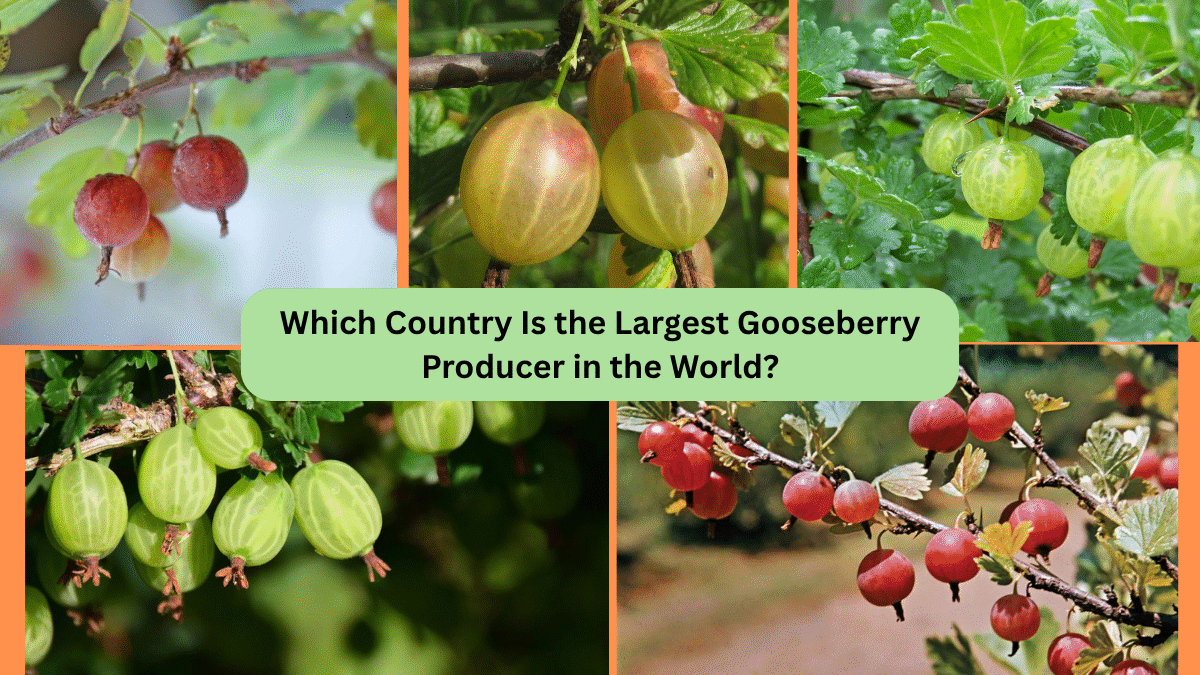Gooseberries — those small, tart, and nutrient-packed berries — have long been cherished in traditional medicine, kitchen recipes, and backyard gardens across Europe and Asia. Known for their versatility and health benefits, these berries thrive in temperate climates and have recently enjoyed a resurgence in popularity due to the growing demand for superfoods.
But which nation leads the world in producing this fascinating fruit? In this comprehensive article, we’ll uncover which country is the largest gooseberry producer in the world, explore the history of the fruit, its health benefits, farming practices, and the global market trends surrounding it.
What Are Gooseberries?
Gooseberries (Ribes uva-crispa) are small, round berries that grow on deciduous shrubs in cool, temperate regions. They come in various shades of green, yellow, red, and purple, depending on the variety. Gooseberries are prized for their unique tart flavor, which can range from sharply acidic to mildly sweet as they ripen.
Rich in vitamin C, antioxidants, and dietary fiber, gooseberries have long been valued both as a culinary ingredient and a natural remedy for a range of health issues.
Which Country Is the Largest Gooseberry Producer in the World?
India is currently the largest gooseberry producer in the world.
Key Production Stats:
- Annual Production: Over 1.2 million metric tons
- Primary Varieties Grown: Indian gooseberry (also known as Amla)
- Main Producing States: Uttar Pradesh, Madhya Pradesh, Gujarat, Rajasthan, Maharashtra, and Tamil Nadu.
India’s dominance is largely due to the cultivation of Phyllanthus emblica, commonly known as Amla or Indian gooseberry, which is botanically different from the European gooseberry (Ribes uva-crispa) but widely recognized in the same category due to similar nutritional and medicinal benefits.
Why Is India the Largest Gooseberry Producer?
Several factors contribute to India’s top position in gooseberry production:
- Favorable Climate: India’s tropical and subtropical climate is highly suitable for growing Indian gooseberries, particularly in states like Uttar Pradesh and Madhya Pradesh.
- High Domestic Demand: Gooseberry, or Amla, holds immense significance in Ayurvedic medicine and is a staple in Indian households for its immunity-boosting, digestive, and cosmetic uses.
- Diverse Uses: Beyond consumption as a fresh fruit, gooseberries in India are processed into powders, pickles, juices, candies, oils, and cosmetics, fueling widespread cultivation.
- Government Support: Various state governments promote gooseberry farming due to its economic viability, drought tolerance, and low maintenance costs.
Other Leading Gooseberry Producing Countries
While India leads globally, several other countries also contribute significantly to gooseberry production, especially the European variety:
Russia
- Russia is a major producer of the European gooseberry (Ribes uva-crispa).
- Gooseberries grow abundantly in rural homesteads and commercial orchards.
- The berries are used in jams, pies, and homemade wines.
United Kingdom
- Historically, gooseberries were widely cultivated in the UK, particularly in northern regions.
- The British have a long-standing tradition of making gooseberry jam, fools, and crumbles.
Germany
- Gooseberries are popular in German cuisine and feature prominently in traditional desserts.
Poland
- An emerging player in European gooseberry production, particularly for export markets.
Gooseberry Farming: Varieties and Cultivation Practices
There are two primary types of gooseberries grown worldwide:
Indian Gooseberry (Amla)
- Botanical Name: Phyllanthus emblica
- Larger fruit, known for high medicinal value.
- Tolerates drought and grows in a variety of soil types.
- Requires minimal care and grows well in tropical and subtropical climates.
Harvest Season: October to February (India)
European Gooseberry
- Botanical Name: Ribes uva-crispa
- Smaller, juicier berries, cultivated mainly for desserts and preserves.
- Prefers cool, temperate climates with moist, well-drained soil.
Harvest Season: June to August (Europe)
Key farming practices include:
- Regular pruning for better air circulation.
- Application of organic manures and bio-fertilizers.
- Protection from pests like aphids and diseases like mildew.
Culinary and Commercial Uses of Gooseberries
Gooseberries are celebrated for their tangy flavor and versatility in the kitchen. Popular uses include:
- Jams, preserves, and chutneys
- Gooseberry pies and crumbles
- Juices, sherbets, and smoothies
- Pickles (especially in India)
- Dried candies and mouth fresheners
- Hair and skin care oils (Amla oil is a bestseller globally)
In Europe, gooseberries are often combined with other fruits for mixed berry jams and compotes.
Health Benefits of Gooseberries
Gooseberries, particularly Indian Amla, have been used in traditional medicine for centuries. Their health benefits include:
- Rich in Vitamin C: Boosts immunity and acts as a powerful antioxidant.
- Aids Digestion: High in fiber and known to improve gut health.
- Good for Skin and Hair: Regular consumption promotes glowing skin and stronger hair.
- Anti-inflammatory and Anti-aging Properties: Thanks to its high antioxidant content.
- Helps Regulate Blood Sugar: Studies suggest Amla may support blood glucose control.
- Supports Heart Health: By reducing cholesterol levels and improving circulation.
Global Gooseberry Market Trends
The demand for gooseberries, especially Indian gooseberry products, has surged in global markets due to rising health awareness and the popularity of natural wellness remedies.
Key market trends include:
- Growth in the organic and herbal supplement industry.
- Increasing use of Amla in haircare and skincare products.
- Expansion of export markets in the USA, Middle East, and Europe.
- Rising demand for functional foods and superfruits.
Countries like India have capitalized on these trends by increasing cultivation areas and investing in food processing and value-added products.
Fun Facts About Gooseberries
- The word “gooseberry” possibly comes from the Old English ‘gros’, meaning ‘to grow’.
- In medieval Europe, gooseberries were considered medicinal before they became popular in culinary recipes.
- Amla trees can live and bear fruit for over 50 years.
- Gooseberry wine was once a popular drink in 18th-century England.
- In traditional British horticulture, competitive gooseberry growing was a serious pastime, with contests for the largest berry.
Challenges in Gooseberry Farming
Despite its benefits, gooseberry farming faces several challenges:
- Susceptibility to mildew and pest attacks in European varieties.
- Limited shelf life of fresh gooseberries, especially in humid conditions.
- Market price fluctuations due to seasonal yields.
- Inconsistent rainfall affecting yields in drought-prone regions.
Modern farming techniques, improved varieties, and post-harvest processing have helped address some of these issues.
Conclusion
To summarize, India proudly holds the title of the largest gooseberry producer in the world, mainly due to the widespread cultivation of the highly valued Amla variety. Its dominance is driven by favorable growing conditions, immense domestic demand, and its revered status in traditional medicine.
Other notable producers include Russia, the UK, Germany, and Poland, which primarily cultivate the European gooseberry for culinary uses. With growing global interest in natural wellness, the future of gooseberry farming — particularly in India — looks bright and promising.
Whether enjoyed fresh, pickled, juiced, or as an ingredient in herbal remedies, gooseberries remain one of the world’s most beneficial and versatile fruits.
FAQs
Q: Which country grows the most gooseberries in the world?
A: India is the world’s largest gooseberry producer.
Q: Are Indian gooseberries and European gooseberries the same?
A: No — Indian gooseberry (Phyllanthus emblica) differs botanically from European gooseberry (Ribes uva-crispa), but both are valued for similar health benefits.
Q: What is Amla used for?
A: Amla is used in herbal medicines, cosmetics, juices, pickles, and health supplements.





Leave A Comment